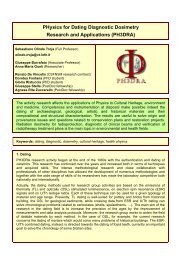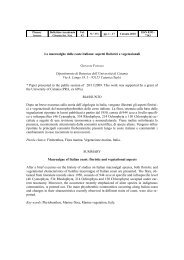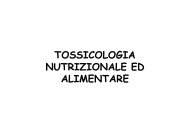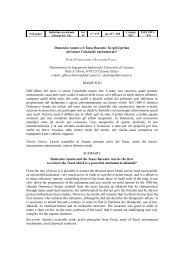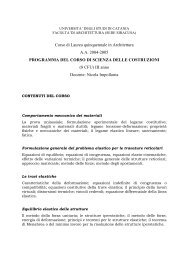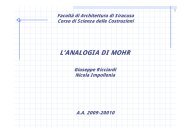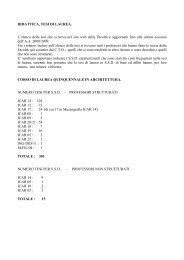taxonomical and phytogeographical investigations on the flora and
taxonomical and phytogeographical investigations on the flora and
taxonomical and phytogeographical investigations on the flora and
Create successful ePaper yourself
Turn your PDF publications into a flip-book with our unique Google optimized e-Paper software.
TAXONOMICAL AND PHYTOGEOGRAPHICAL INVESTIGATIONS<br />
ON THE FLORA AND VEGETATION OF THE MEDITERRANEAN<br />
AREA<br />
Salvatore Brullo (Full Professor)<br />
salvo.brullo@gmail.com<br />
Gianpietro Giusso del Galdo (Associate<br />
Professor)<br />
Giuseppina Bartolo (Researcher)<br />
Santa Gloria Pulvirenti (Researcher)<br />
Pietro Minissale (Researcher)<br />
Maria Carmen Terrasi (Researcher)<br />
Saverio Sci<str<strong>on</strong>g>and</str<strong>on</strong>g>rello (Scholarship Holder)<br />
Cristian Brullo (Temporary Research<br />
Associate)<br />
Carmelo Maria Musarella (PhD Student)<br />
Le<strong>on</strong>ardo Scuderi (PhD Student)<br />
Fig. 1 Asperula peloritana Brullo et al.<br />
The <str<strong>on</strong>g>investigati<strong>on</strong>s</str<strong>on</strong>g> carried out by us are chiefly focused <strong>on</strong> <strong>the</strong> <strong>flora</strong> <str<strong>on</strong>g>and</str<strong>on</strong>g> vegetati<strong>on</strong> of <strong>the</strong><br />
Mediterranean area. In particular, our researches regard tax<strong>on</strong>omy, karyology, plant<br />
distributi<strong>on</strong>, <str<strong>on</strong>g>and</str<strong>on</strong>g> ecology of rare species or critical groups, in order to clarify <strong>the</strong>ir systematic<br />
<str<strong>on</strong>g>and</str<strong>on</strong>g> phylogenetic positi<strong>on</strong>. Fur<strong>the</strong>rmore, <strong>the</strong> plant communities characterizing <strong>the</strong><br />
Mediterranean envir<strong>on</strong>ment are examined from <strong>the</strong> ecological, syn<str<strong>on</strong>g>tax<strong>on</strong>omical</str<strong>on</strong>g>, <str<strong>on</strong>g>and</str<strong>on</strong>g><br />
c<strong>on</strong>servati<strong>on</strong> viewpoint.<br />
Keywords: Flora, Vegetati<strong>on</strong>, Mediterranean, Tax<strong>on</strong>omy, Phytogeography<br />
1. Tax<strong>on</strong>omy, karyology, phylogeny of <strong>the</strong> Mediterranean plants<br />
The Mediterranean <strong>flora</strong> is still not well known, since <strong>the</strong>re are many critical species or groups<br />
requiring in-depth studies aiming at clarify <strong>the</strong>ir systematic positi<strong>on</strong>. Such <str<strong>on</strong>g>investigati<strong>on</strong>s</str<strong>on</strong>g> are mainly<br />
based <strong>on</strong> <strong>the</strong> observati<strong>on</strong> of living or dried material for <strong>the</strong> morphological analyses, micromorphological<br />
structures of seeds, fruits <str<strong>on</strong>g>and</str<strong>on</strong>g> pollens, leaf anatomy, chromosome number <str<strong>on</strong>g>and</str<strong>on</strong>g><br />
structure of <strong>the</strong> karyotypes, as well as <strong>the</strong> biomolecular examinati<strong>on</strong> of nuclear, plastidial <str<strong>on</strong>g>and</str<strong>on</strong>g><br />
ribosomal genoma. The nomenclatural researches, based <strong>on</strong> literature <str<strong>on</strong>g>and</str<strong>on</strong>g> herbarium data, are<br />
extremely useful to trace <strong>the</strong> type specimens of a given tax<strong>on</strong>. The ecological requirements,<br />
geographical distributi<strong>on</strong>s, c<strong>on</strong>servati<strong>on</strong> status <str<strong>on</strong>g>and</str<strong>on</strong>g> <str<strong>on</strong>g>tax<strong>on</strong>omical</str<strong>on</strong>g> relati<strong>on</strong>ships of <strong>the</strong> surveyed taxa<br />
are examined too. These <str<strong>on</strong>g>investigati<strong>on</strong>s</str<strong>on</strong>g> allow a better definiti<strong>on</strong> of <strong>the</strong> systematic positi<strong>on</strong> of <strong>the</strong> taxa,<br />
often bringing to <strong>the</strong> recogniti<strong>on</strong> of species new to science thus increasing <strong>the</strong> biodiversity of <strong>the</strong><br />
Mediterranean <strong>flora</strong>. Am<strong>on</strong>g <strong>the</strong> numerous examined genera can be menti<strong>on</strong>ed: Allium, Lim<strong>on</strong>ium,<br />
Astragalus, Armeria, Scilla, Silene, Dianthus, Chiliadenus, An<strong>the</strong>mis, Centaurea, Peucedanum,<br />
Thapsia, Hypericum, Helian<strong>the</strong>mum, Sedum, Crassula, Asperula, Ophrys, Limodorum, Serapias,<br />
Epipactis, Bellevalia, Koeleria, Cephalaria, etc., in which many new species were described or was
clarified <strong>the</strong> <str<strong>on</strong>g>tax<strong>on</strong>omical</str<strong>on</strong>g> positi<strong>on</strong> of many critical species.<br />
2. Chromosomal studies <strong>on</strong> Mediterranean orchids<br />
Karyological studies <strong>on</strong> <strong>the</strong> orchids occurring in Mediterranean territories were carried out. For <strong>the</strong>se<br />
<str<strong>on</strong>g>investigati<strong>on</strong>s</str<strong>on</strong>g> were used ovules from immature ovaries <str<strong>on</strong>g>and</str<strong>on</strong>g> treated using Feulgen <str<strong>on</strong>g>and</str<strong>on</strong>g> Giemsa<br />
b<str<strong>on</strong>g>and</str<strong>on</strong>g>ing methods. The first technique allows to examine <strong>the</strong> metaphase plates in order to verify <strong>the</strong><br />
chromosome complement <str<strong>on</strong>g>and</str<strong>on</strong>g> to elaborate <strong>the</strong> karyotype, while <strong>the</strong> sec<strong>on</strong>d <strong>on</strong>e allows to highlight<br />
<strong>the</strong> heterochromatin distributi<strong>on</strong> in <strong>the</strong> each chromosome. In particular, <strong>the</strong> examined species are<br />
Epipactis asprom<strong>on</strong>tana, Epipactis schubertiorum, Neottia nidus-avis, Oprhys ferrum-equinum <str<strong>on</strong>g>and</str<strong>on</strong>g><br />
Ophrys oestrifera, all coming from various localities of Sicily, Italy <str<strong>on</strong>g>and</str<strong>on</strong>g> Greece.<br />
3. Botanical museology<br />
Investigati<strong>on</strong>s regarding <strong>the</strong> history <str<strong>on</strong>g>and</str<strong>on</strong>g> <strong>the</strong> present arrangement of <strong>the</strong> Sicilian Botanical Garden<br />
from Catania allowed to rec<strong>on</strong>struct <strong>the</strong> origin <str<strong>on</strong>g>and</str<strong>on</strong>g> <strong>the</strong> subsequent modificati<strong>on</strong>s of <strong>the</strong> planimetry, as<br />
well as <strong>the</strong> placing <str<strong>on</strong>g>and</str<strong>on</strong>g> changes of <strong>the</strong> plants. Since its foundati<strong>on</strong>, this botanical garden underg<strong>on</strong>e<br />
remarkable changes as c<strong>on</strong>cerns <strong>the</strong> architecture <str<strong>on</strong>g>and</str<strong>on</strong>g> floristic settlement. Purposes <str<strong>on</strong>g>and</str<strong>on</strong>g> functi<strong>on</strong>s of<br />
<strong>the</strong> botanical garden changed many times depending to <strong>the</strong> different historical periods <str<strong>on</strong>g>and</str<strong>on</strong>g><br />
viewpoints of its Directors. Afterwards, <strong>the</strong> Sicilian Botanical Garden has been underg<strong>on</strong>e substantial<br />
restorati<strong>on</strong>s in line with <strong>the</strong> most recent ecological criteria. Actually, it is arranged in various sectors<br />
reproducing <strong>the</strong> typical habitats of <strong>the</strong> Sicilian l<str<strong>on</strong>g>and</str<strong>on</strong>g>scape. The most characteristic species, most of<br />
which are endemic, has been placed in each habitat. In this view, <strong>the</strong> Sicilian Botanical Garden has<br />
<strong>the</strong> purpose to ensure <strong>the</strong> ex-situ c<strong>on</strong>servati<strong>on</strong> of many endangered species, <str<strong>on</strong>g>and</str<strong>on</strong>g> intends to show to<br />
<strong>the</strong> public a cross-secti<strong>on</strong> of <strong>the</strong> Sicilian l<str<strong>on</strong>g>and</str<strong>on</strong>g>scape, thus favouring a more acquaint envir<strong>on</strong>mental<br />
awareness.<br />
4. Phytosociology <str<strong>on</strong>g>and</str<strong>on</strong>g> l<str<strong>on</strong>g>and</str<strong>on</strong>g>scape studies<br />
Envir<strong>on</strong>mental studies are extremely important for <strong>the</strong> recogniti<strong>on</strong> of <strong>the</strong> plant communities<br />
characterizing <strong>the</strong> Sicilian l<str<strong>on</strong>g>and</str<strong>on</strong>g>scape. In particular, such studies are useful <str<strong>on</strong>g>and</str<strong>on</strong>g> essential for many<br />
types of habitat restorati<strong>on</strong> plans, envir<strong>on</strong>mental improvement, plant m<strong>on</strong>itoring programmes, l<str<strong>on</strong>g>and</str<strong>on</strong>g><br />
management, <str<strong>on</strong>g>and</str<strong>on</strong>g> so <strong>on</strong>. These studies are chiefly based <strong>on</strong> <strong>the</strong> phytosociological method, which<br />
allows a floristic, ecological, structural, syndinamic, functi<strong>on</strong>al, <str<strong>on</strong>g>and</str<strong>on</strong>g> syn<str<strong>on</strong>g>tax<strong>on</strong>omical</str<strong>on</strong>g> characterizati<strong>on</strong><br />
of each plant community. These researches are also implemented with cartographic studies of <strong>the</strong><br />
natural vegetati<strong>on</strong>, thus providing an updated informatic database of <strong>the</strong> distributi<strong>on</strong> of <strong>the</strong> plant<br />
communities occurring in a given territory. Such database are extremely important since <strong>the</strong>y are<br />
useful for ensuring a better management of <strong>the</strong> natural areas (Reserves, SCI, SPZ, <str<strong>on</strong>g>and</str<strong>on</strong>g> natural<br />
parks). In particular, several studies have been carried out for <strong>the</strong> survey of <strong>the</strong> Sicilian vegetati<strong>on</strong>,<br />
<str<strong>on</strong>g>and</str<strong>on</strong>g> many o<strong>the</strong>r Mediterranean territories. Special studies focused <strong>on</strong> some peculiar vegetati<strong>on</strong> types<br />
(such as dry grassl<str<strong>on</strong>g>and</str<strong>on</strong>g>s, evergreen oak-woods, etc.) have been carried out too.<br />
5. C<strong>on</strong>servati<strong>on</strong> of plants biodiversity<br />
The biodiversity crisis, due to various human activities, is a topic of great relevance, <str<strong>on</strong>g>and</str<strong>on</strong>g> requires<br />
appropriate management <str<strong>on</strong>g>and</str<strong>on</strong>g> c<strong>on</strong>servati<strong>on</strong> policies supported by adequate knowledge <strong>on</strong> <strong>the</strong><br />
c<strong>on</strong>sistency <str<strong>on</strong>g>and</str<strong>on</strong>g> c<strong>on</strong>servati<strong>on</strong> status of species, habitats <str<strong>on</strong>g>and</str<strong>on</strong>g> ecosystems. In this regard, <strong>the</strong><br />
implementati<strong>on</strong> <str<strong>on</strong>g>and</str<strong>on</strong>g> updating of "red lists", as str<strong>on</strong>gly suggested by <strong>the</strong> Global Strategy for Plant<br />
C<strong>on</strong>servati<strong>on</strong> (GSPC/CBD) <str<strong>on</strong>g>and</str<strong>on</strong>g> <strong>the</strong> European Plant C<strong>on</strong>servati<strong>on</strong> Strategy (EPCS), are of<br />
fundamental importance <str<strong>on</strong>g>and</str<strong>on</strong>g> c<strong>on</strong>stitute an indispensable tool for <strong>the</strong> l<str<strong>on</strong>g>and</str<strong>on</strong>g> management. We<br />
developed <strong>the</strong>se issues through <strong>the</strong> use of st<str<strong>on</strong>g>and</str<strong>on</strong>g>ards proposed by <strong>the</strong> World C<strong>on</strong>servati<strong>on</strong> Uni<strong>on</strong><br />
(IUCN), <strong>on</strong> species of Italian <str<strong>on</strong>g>and</str<strong>on</strong>g> Sicilian <strong>flora</strong>. O<strong>the</strong>r fields of this issue is <strong>the</strong> knowledge of plant<br />
biodiversity in protected areas, useful for <strong>the</strong> planning <str<strong>on</strong>g>and</str<strong>on</strong>g> management of <strong>the</strong>se areas.
Fig. 2 Metaphase plate <str<strong>on</strong>g>and</str<strong>on</strong>g> idiogram of Bellevalia pelagica Brullo et al.<br />
Collaborati<strong>on</strong>s <str<strong>on</strong>g>and</str<strong>on</strong>g> Research Grants<br />
• Prof. Cristina Salmeri (University of Palermo, Italy)<br />
• Prof. Giuseppe Bazan (University of Palermo, Italy)<br />
• Dr. Riccardo Guarino (University of Palermo, Italy)<br />
• Prof. Giovanni Spampinato (University of Reggio Calabria, Italy)<br />
• Prof. Gianluigi Bacchetta (University of Cagliari, Italy)<br />
• Prof. Ant<strong>on</strong>io Scrugli (University of Cagliari, Italy)<br />
• Prof. Josep A. Rosselló (University of Valencia, Spain)<br />
• Dr. S<str<strong>on</strong>g>and</str<strong>on</strong>g>ro Bogdanovic (University of Zagabria, Croatia)<br />
• Dr. Antun Alegro (University of Zagabria, Croatia)<br />
• Dr. Corrado Marcenò (Palermo, Italy)<br />
• Dr. Salvatore Pasta (Palermo, Italy)<br />
• Dr. Saverio D'Emerico (Bari, Italy)<br />
• ENI S.p.a (Roma, Italy)<br />
Selected Publicati<strong>on</strong>s<br />
• Brullo, C., Brullo, S., Pasta, S. (2009). Bellevalia pelagica (Hyacinthaceae), a new species from <strong>the</strong> islet<br />
of Lampi<strong>on</strong>e (Pelagian Archipelago, Sicily) in Edinb. J. Bot. 66(1), 1-11<br />
• Brullo, S., Giusso del Galdo, G., Minissale, P. (2009). Tax<strong>on</strong>omical revisi<strong>on</strong> of Koeleria splendens C.<br />
Presl group (Poaceae) in <strong>the</strong> Italian territory in Pl. Biosystems 143(1), 140-161<br />
• Bogdanović, S., Brullo, S., Giusso del Galdo, G. & Salmeri, C. (2009). A new autumn-flowering species<br />
of Allium (Alliaceae) from Croatia in Folia Geobot. 44, 83-93.<br />
• Brullo, S., Gianguzzi, L., La Mantia, A., Siracusa, G. (2009). La classe Quercetea ilicis in Sicilia in Boll.<br />
Acc. Gioenia Sci. Nat. 41(369), 1-77.<br />
• Brullo, C., Brullo, S., Giusso del Galdo, G., Pav<strong>on</strong>e, P., Salmeri, C. (2009). Prospero hierae<br />
(Hyacinthaceae), a new species from Marettimo Isl<str<strong>on</strong>g>and</str<strong>on</strong>g> (Sicily) in Phyt<strong>on</strong> (Horn, Austria) 49(1), 93-104.
• Brullo, C., Brullo, S., Giusso del Galdo, G., Scuderi, L. (2009). Tax<strong>on</strong>omical notes <strong>on</strong> <strong>the</strong> Sicilian<br />
populati<strong>on</strong>s of Asperula guss<strong>on</strong>ei Boiss. (Rubiaceae): A peloritana sp. nov. in Anal. Jard. Bot. Madrid<br />
66(1), 85-92.<br />
• Brullo, S., Guglielmo, A., Pasta, S., Pav<strong>on</strong>e, P., Salmeri, C. (2009). Note citotass<strong>on</strong>omiche sul genere<br />
Thapsia L. (Apiaceae) in Inf. Bot. Ital. 40(suppl.3), 41-48.<br />
• Brullo, C., Brullo, S. (2009). C<strong>on</strong>siderazi<strong>on</strong>i su alcune specie critiche della <strong>flora</strong> sicula in SBI Gruppo per<br />
la Floristica, 43-44, Roma.<br />
• Alegro, A., Bogdanović, S., Brullo, S., Giusso del Galdo, G. (2009). Astragalus croaticus (Fabaceae), a<br />
new species from Croatia in Ann. Bot. Fennici 46, 569-573.<br />
• Rosselló, J.A., Cosín, R., Bacchetta, G., Brullo, S., Mayol, M. (2009). Nuclear <str<strong>on</strong>g>and</str<strong>on</strong>g> chloroplast DNA<br />
variati<strong>on</strong> in Cephalaria squami<strong>flora</strong> (Dipsacaceae), a disjunct Mediterranean species in Tax<strong>on</strong> 58(4),<br />
1242-1253.<br />
• Brullo, S., Pav<strong>on</strong>e, P., Salmeri, C., Terrasi, M.C (2009). Allium garganicum (Alliaceae), a new species<br />
from Apulia (SE Italy) in Pl. Biosyst. 143(Suppl.), 78-84.<br />
• Brullo, C, Brullo, S., Giusso del Galdo, G, Guarino, R., Minissale, P., Scuderi, L., Siracusa, G.,<br />
Sci<str<strong>on</strong>g>and</str<strong>on</strong>g>rello, S., Spampinato, G. (2010). The Lygeo-Stipetea class in Sicily in Ann. Bot. (Roma) 0, 57-84.<br />
• Bacchetta, G., Brullo, S., Casti, M., Giusso del Galdo, G. (2010). Tax<strong>on</strong>omic revisi<strong>on</strong> of <strong>the</strong> Dianthus<br />
sylvestris group (Caryophyllaceae) in central-sou<strong>the</strong>rn Italy, Sicily <str<strong>on</strong>g>and</str<strong>on</strong>g> Sardinia in Nordic J. Bot. 28, 137-<br />
173.<br />
• Brullo, C., Brullo, S., Giusso del Galdo, G., Salmeri, C. (2010). Allium makrianum (Alliaceae), a new<br />
autumnal species from Greece in Phyt<strong>on</strong> (Horn, Austria) 49, 267-278.<br />
• Bazan, G., Brullo, S., Raim<strong>on</strong>do, F.M., Schicchi, R. (2010). La serie di vegetazi<strong>on</strong>e della Regi<strong>on</strong>e Sicilia<br />
in Blasi C. (ed.), La vegetazi<strong>on</strong>e d’Italia, 429-469. Palombi & Partner S.r.l., Roma.<br />
• Bacchetta, G., Brullo, S. (2010). Astragalus tegulensis Bacch. & Brullo (Fabaceae), a new species from<br />
Sardinia in C<str<strong>on</strong>g>and</str<strong>on</strong>g>ollea 65, 5-14.<br />
• Bacchetta, G., Brullo, S., Salmeri, C. (2010). Hypericum scruglii sp. nov. (Guttiferae) from Sardinia in<br />
Nordic J. Bot. 28, 469-474.<br />
• Bartolo, G., Brullo, C., D'Emerico, S., Pulvirenti, S , Scrugli, A. & Terrasi, M.C. (2010). Advances in<br />
chromosomal studies in Neottiae (Orchidaceae): c<strong>on</strong>stitutive heterocromatin, chromosomal<br />
rearrangements <str<strong>on</strong>g>and</str<strong>on</strong>g> speciati<strong>on</strong> in Caryologia 63(2), 184-191.<br />
• Bartolo, G., D'Emerico, S., Pulvirenti, S. (2010). Studio cariologico di Ophrys ferrum–equinum<br />
Desf<strong>on</strong>taines e Ophrys oestrifera Steven della Grecia (Orchidaceae) in J. Eur. Orch. 42(3/4), 535 540.<br />
• Bartolo, G., Brullo, C. & Pulvirenti, S. (2010). Storia scientifica e assetto attuale dell’Orto siculo<br />
dell’Università di Catania in Boll. Acc. Gioenia Sci. Nat. 42(372), 139-160.<br />
• Brullo, C., Giusso del Galdo, G., Marcenò, C., Minissale, P., Sci<str<strong>on</strong>g>and</str<strong>on</strong>g>rello, S. (2010). Schede per una<br />
Lista Rossa della Flora Italiana - Leopoldia guss<strong>on</strong>ei Parl. Inform. Bot. Ital. 42(2), 609-611.<br />
• Brullo, C., Giusso del Galdo, G., Minissale, P., Sci<str<strong>on</strong>g>and</str<strong>on</strong>g>rello, S. (2010). Schede per una Lista Rossa della<br />
Flora Italiana - Helian<strong>the</strong>mum sicanorum Brullo, Giusso & Sci<str<strong>on</strong>g>and</str<strong>on</strong>g>rello. Inform. Bot. Ital. 42 (2), 604-605.<br />
• Messina, F., Minissale, P. (2010). Schede per una Lista Rossa della Flora Italiana - Sisymbrella dentata<br />
(L.) O.E.Schulz. Inform. Bot. Ital. 42(2), 624-626.<br />
• Minissale, P., Sci<str<strong>on</strong>g>and</str<strong>on</strong>g>rello, S. (2010). Flora e vegetazi<strong>on</strong>e terrestre della Riserva Naturale di Vendicari<br />
(Sicilia sud-orientale). In: Petralia A.. Atti del c<strong>on</strong>vegno "L'area protetta di Vendicari" - Case Cittadella<br />
Vendicari 25-26 ottobre 2008. p. 131-194, NOTO: Ente Fauna Siciliana.




